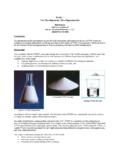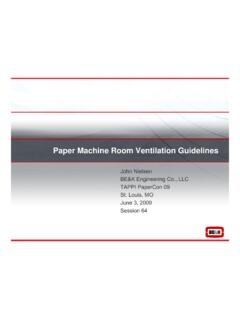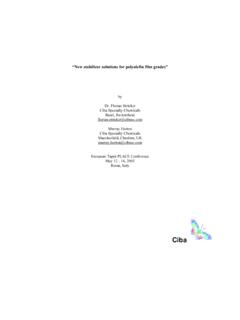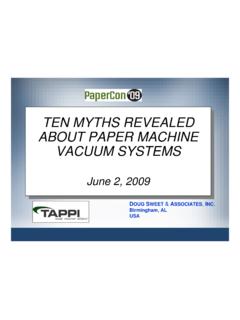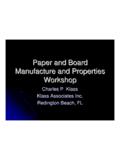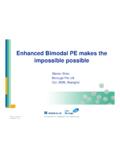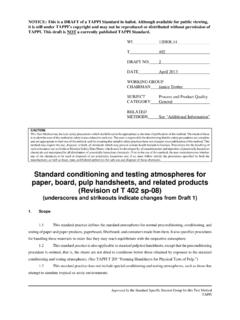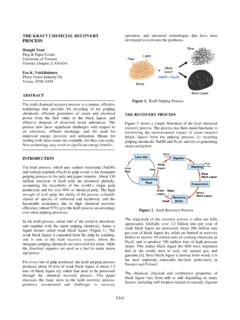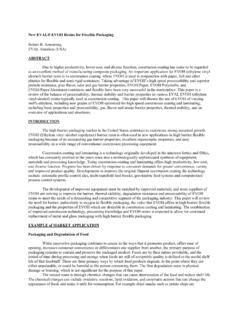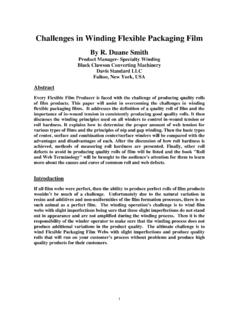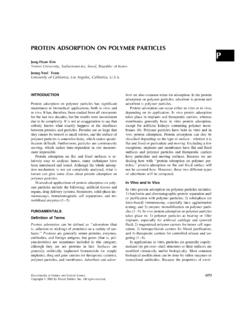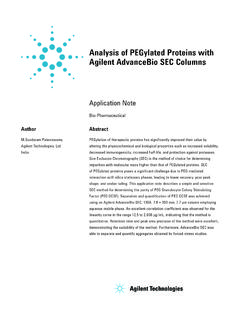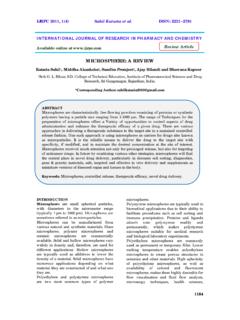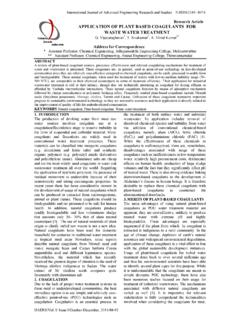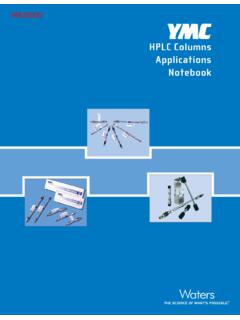Transcription of Natural Surfactants for Flotation Deinking in Paper Recycling
1 Natural Surfactants for Flotation Deinking in Paper Recycling R. A. Venditti, O. J. Rojas, H. Morris, J. Tucker, K. Spence, C. Austin, L. G. Castillo* Forest Biomaterials Science and Engineering, North Carolina State University, USA and *Department of Wood Pulp and Paper , University of Guadalajara, Mexico ABSTRACT The objective of this research was to evaluate new types of Surfactants based on renewable materials (sugar and protein-based Surfactants ) for use in ink removal from recycled Paper via Flotation Deinking . By applying green chemistry approaches we aim to minimize the environmental impact of Deinking agents and also to open an avenue for a number of products that are to be generated from the utilization of biomass. Foamability and foam stability by the respective Surfactants were considered and detergency experiments via piezoelectric sensing were used to unveil their fundamental differences in terms of surface activity.
2 Lab scale Flotation Deinking efficiency was measured primarily by image analysis and Flotation yield determined gravimetrically. We demonstrated that sugar-based Surfactants are viable replacements to petroleum-based Surfactants in Flotation . Differences in Flotation efficiency could be explained based on foaming, detergency and adsorption characteristics of the Surfactants . INTRODUCTION In Paper Recycling , Deinking operations are used to remove the ink from the recovered Paper by washing and Flotation processes. In Flotation , the ink is separated from the fibers by the injection of air in the presence of a foaming agent (McCool, 1993). Rising bubbles (foam) carry away the ink particles which are separated from the top of the Flotation vat (Figure 1).
3 Some fibers are lost in the reject stream or froth (foam and ink) and therefore the fiber yield is less than 100%. Likewise, some ink particles remain in the fiber accepts and therefore the final Paper quality depends on the selectivity of the separation process. The key operational steps in Flotation involve the use of Surfactants to ensure the detachment of the ink from the fibers (detergency) and the formation of a stable foam that can be separated from the pulp during the Flotation stage. In a typical process the amount of surfactant used is about % based on oven-dry fiber mass. The effect of the surfactant on the attachment of ink and other hydrophobic particles to the air bubbles is complex. The surfactant can exist at the ink-water interface, the ink-air interface and the air-water interface, changing the surface characteristics.
4 There has been some recent interest in Flotation processes in which the surfactant is sprayed on the top of the Flotation cell rather than mixed with the pulp prior to Flotation (DeLozier et al, 2005). Laboratory and pilot plant experiments have demonstrated improvements in the Flotation process. It is suggested that mixing the surfactant into the pulp before Flotation may cause surfactant to adsorb to the pulp fibers making them more hydrophobic and adsorb to the ink particles making them more hydrophilic. This decreases the affinity of the air bubbles to the ink relative to the fibers and lowers Flotation Deinking efficiency and fiber yield. In the spray surfactant process this indiscriminant adsorption of Surfactants on fiber and ink is reduced.
5 Rejects: foam + inkAccepts: Pulp suspension (deinked Pulp)airPulp + SurfactantRejects: foam + inkAccepts: Pulp suspension (deinked Pulp)airPulp + SurfactantFigure 1: A simple Flotation cell for recycled Paper Foaming is another key performance attribute of Flotation Surfactants . It has been found that Surfactants have the ability to promote foaming above and below their critical micelle concentration (a concentration in which the Surfactants aggregate into micelles in the bulk of the solution) (Borchardt, 1992). It has been found for linear alkyl benzene sulfonates that the foaming activity of the surfactant increases with length of the alkyl chain. It has also been shown that anionic Surfactants tend to foam more readily than non-ionic ones with the same hydrophobe.
6 Two of the most common types of Surfactants used for Deinking are fatty acid soaps and polyethyleneoxide alkyl ethers, which are classified as anionic and non-ionic Surfactants , respectively. The case of nonylphenol ethoxylates (NP) is particularly significant. Nonylphenol is a mixture of isomeric monoalkyl phenols, predominately para- substituted, found in the environment primarily as a biodegradation product of nonylphenol ethoxylates. Nonylphenols used as a nonionic surfactant result in its release to the environment through various waste streams in Paper Recycling operations. The National Library of Health (NIH) reports these Surfactants as severely irritating to skin and eyes if present in high concentrations (International Labour Office, 1998).
7 NIOSH (NOES Survey 1981-1983) has statistically estimated that 306,211 workers are potentially exposed to nonylphenol in the US (NIOSH, 1983). Monitoring data indicate that the general population may be exposed to nonylphenol via dermal contact or ingestion of water containing nonylphenol (Lewis, 97). Nonylphenols are suspected to be endocrine disruptors, meaning they have adverse effects on the workings of the endocrine system in humans and animals (Ren, 1997). Many European countries have banned the use of NP at given concentrations. No Recycling mill in Europe is using NP and most mills are asking for readily biodegradable Deinking agents. Therefore, there is an important need to understand the behavior environmentally-friendly Surfactants in the Paper Deinking process.
8 EXPERIMENTAL Surfactant Materials The main Deinking agents discussed in this study involve alkyl phenol ethoxylates, sugar-based, protein-based and a proprietary surfactant mixture. The ethoxylated surfactant consisted of octylphenol ethoxylated with an average number of ethylene oxide units per molecule of (CASR No: 9002-93-1) with 33 mN/m surface tension and 108 mm Ross Miles foam at 5 min ( , 25 C in DI water). The sugar-based surfactant was an alkyl (C10-C16) mono and oligomeric D- glucopyranose (CASR No. 110615-47-9) with mN/m surface tension and 110 mm Ross Miles foam at 5 min ( , 25 C in DI water). The protein-based surfactant is derived from soybean and is a polymer composed of around 25 different types of amino acids linked with amide bonds with a weight averaged molecular weight of around 100k-300k.
9 The amino acids contain a basic amino group (NH2) and an acidic carboxyl group (COOH). The polymer is amphoteric in solution and has a net anionic charge. Only at pH values above 7 is the polymer fully soluble, with the acid groups ionized under alkaline conditions (this surfactant has negligible foaming ability under the conditions of the Ross Miles standard). A proprietary commercial Flotation Deinking aid intended for mixed office recovered Paper based on a non-ionic surfactant blend was used as a comparison ( mm Ross Miles foam at 5 min ( , 25 C in DI water). All of these surfactant mixtures were received as donations from different chemical suppliers. The experimental approach involved the measurement of the Deinking ability for a standard printed (recycled) Paper .)
10 A fundamental study was conducted on surfactant activity that involved detergency, foamability and foam stability tests. The application of the Surfactants in bench-scale operations by Flotation Deinking was performed thereafter. Procedures Detergency We studied the detergency ability of the different Surfactants by using a model ink. Ink in printed Paper is the main component of concern in the Recycling operation, , a number of energy-intensive steps is aimed at removing ink from the substrate (printed Paper ). The use of model inks deposited on flat, smooth surfaces allowed us to understand, from first principles, the fundamental differences between the Surfactants tested. Tripalmitin, a fatty acid, was chosen to create model thin films of ink on gold surfaces.
